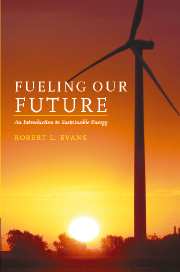Book contents
- Frontmatter
- Contents
- Preface
- Acknowledgments
- Glossary
- Part I Setting the scene
- Part II The global energy demand and supply balance
- Part III New and sustainable energy sources
- Part IV Towards a sustainable energy balance
- 9 The transportation challenge
- 10 Achieving a sustainable energy balance
- Index
- References
10 - Achieving a sustainable energy balance
Published online by Cambridge University Press: 05 June 2012
- Frontmatter
- Contents
- Preface
- Acknowledgments
- Glossary
- Part I Setting the scene
- Part II The global energy demand and supply balance
- Part III New and sustainable energy sources
- Part IV Towards a sustainable energy balance
- 9 The transportation challenge
- 10 Achieving a sustainable energy balance
- Index
- References
Summary
In the preceding chapters we examined current energy demand and supply patterns, as well as some projections for future global energy demand. We then discussed the fact that all of our energy requirements must be met, ultimately, from some combination of only three primary energy sources; fossil fuels, renewable energy, and nuclear power. Increasing concerns about the environmental effects of large-scale fossil fuel usage, as well as uncertainties about the long-term availability of these fuels, particularly crude oil, provided the background for further exploration of alternative energy supply strategies. We discussed the need to move, in the long term, from an overwhelming reliance on fossil fuels to provide nearly 80% of our total energy requirements, to a more sustainable energy supply mix. We went on to discuss the prospects for some of the alternatives to fossil fuels, including increased use of renewable energy and nuclear power, primarily to generate electricity. Consideration was also given to a more sustainable way of using fossil fuels by capturing and storing carbon dioxide, although the technology for doing so is at an early stage of development. Finally, we speculated that the move away from fossil fuels may, in large part, come about as a result of changing from petroleum fuels to electricity as the energy carrier to supply most of our transportation energy needs.
- Type
- Chapter
- Information
- Fueling Our Future: An Introduction to Sustainable Energy , pp. 165 - 176Publisher: Cambridge University PressPrint publication year: 2007



